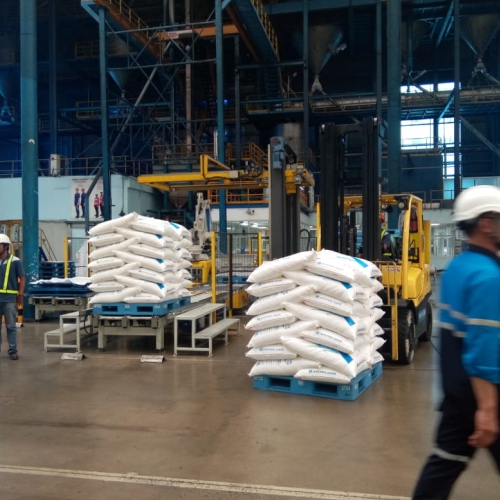India’s sugar industry, a pillar of the nation’s agricultural sector, offers a bounty beyond mere table sugar. This industry generates valuable by-products that present significant opportunities for value addition and contribute to India’s energy security. This blog delves into three key aspects: ethanol, bio-CNG, and potash fertilizers, highlighting their roles in transforming the sugar industry and driving sustainable development.
1. Ethanol: A Sustainable Path
Current Landscape
India’s sugar industry, despite its significant contributions to the economy, faces challenges due to excess sugar production. This surplus leads to financial stress for sugar mills, struggling to maintain profitability and ensure timely payments to farmers. In this scenario, ethanol production emerges as a beacon of hope, offering a sustainable solution to mitigate these issues.
Ethanol, an alcohol-based fuel, can be blended with petrol to power vehicles, reducing reliance on fossil fuels. This not only helps manage the surplus sugar but also aligns with global efforts to combat climate change by reducing greenhouse gas emissions.
Policy and Roadmap
The Indian government has recognized the potential of ethanol in transforming the sugar industry and enhancing energy security. The National Policy on Biofuels outlines a comprehensive roadmap for integrating ethanol production into sugar industry operations.
Key objectives of this policy include:
Reducing Sugar Surplus: Diverting excess sugar towards ethanol production helps stabilize sugar prices and ensures better financial health for sugar mills.
Improving Air Quality: Ethanol-blended fuel reduces harmful emissions, contributing to cleaner air and a healthier environment.
Creating Jobs: The expansion of ethanol production facilities creates employment opportunities, particularly in rural areas.
Reducing Oil Dependence: By substituting a portion of petrol with ethanol, India can reduce its oil import bill, enhancing energy security.
Promoting Renewable Energy: Ethanol is a renewable energy source, supporting the country’s transition towards a sustainable energy future.
Benefits for Sugar Mills
The integration of ethanol production into the sugar industry offers multiple benefits:
Mitigating Price Fluctuations: By producing ethanol, sugar mills can diversify their revenue streams, reducing their dependence on sugar prices, which are often volatile.
Ensuring Timely Payments to Farmers: Enhanced profitability from ethanol sales enables mills to make timely payments to farmers, fostering a more stable agricultural ecosystem.
Reducing Sugar Glut: Diverting excess sugar towards ethanol production helps manage the surplus, preventing market crashes due to oversupply.
Enhancing Financial Health: Diversified income from ethanol production contributes to the overall financial stability of sugar mills.
Beyond Transportation
Ethanol’s potential extends beyond its use as a transportation fuel. Innovations in this sector open new avenues for its application:
Flex-Fuel Vehicles (FFVs): These vehicles can run on higher ethanol blends, offering a practical solution to reduce petrol consumption.
Ethanol Pumps and Retail Outlets: Establishing dedicated ethanol fuel stations can make it more accessible to consumers, encouraging its widespread adoption.
Sustainable Aviation Fuel (SAF): Research is underway to develop ethanol-based fuels for aviation, which could significantly reduce the carbon footprint of air travel.
Cellulosic Ethanol: This advanced form of ethanol is produced from agricultural residues and non-food crops, further expanding the scope of renewable energy sources.
2. Bio-CNG: Transforming Waste to Wealth
Challenges
The sugar industry not only grapples with price instability but also faces significant environmental concerns. Traditional waste disposal methods, such as open dumping and incineration, contribute to pollution and waste management challenges. However, the advent of Bio-CNG offers a transformative solution, turning waste into a valuable resource.
Government Support
Recognizing the potential of Bio-CNG, the Indian government launched the Sustainable Alternative Towards Affordable Transportation (SATAT) scheme. This initiative aims to establish 5,000 Bio-CNG plants by 2023-24, focusing on reducing carbon emissions and fostering waste-to-energy technologies.
Waste to Wealth
Bio-CNG production leverages sugarcane by-products, such as press mud, spent wash, and bagasse, to create renewable transport fuel. This not only addresses waste disposal issues but also generates additional revenue for sugar mills. The process involves anaerobic digestion, where microorganisms break down organic matter in the absence of oxygen, producing biogas. This biogas is then purified to produce Bio-CNG.
Future Possibilities
The potential of Bio-CNG extends beyond current applications. Future developments may include:
Bio-Hydrogen: Research is ongoing to explore the production of bio-hydrogen, a clean energy carrier, from agricultural waste.
Biomethane Enrichment: Enhancing the quality of biomethane to meet stringent fuel standards can broaden its use in various sectors, including industrial applications.
3. Potash Fertilizers: Enhancing Sugar
Potash fertilizers play a crucial role in maximizing sugarcane yield and quality. They contribute to a healthy crop by:
Strengthening Plant Structure: Potash helps in the development of strong cell walls, making sugarcane plants more resistant to diseases and environmental stress. Stronger plants are better equipped to withstand harsh weather conditions and pest infestations.
Improving Sugar Content: Adequate potash levels in the soil enhance the sugar content in sugarcane. This translates to higher yields of sugar per hectare, leading to increased profitability for farmers.
Government Initiatives
The Indian government has implemented several initiatives to promote the use of potash fertilizers derived from sugar industry by-products:
PDM Sales by Sugar Mills: Potash derived from molasses (PDM) is being promoted for sale by sugar mills,providing an additional revenue stream. PDM offers a cost-effective alternative to traditional potash fertilizers,benefiting both farmers and sugar mills.
PDM Subsidy and NBS Inclusion: The government offers subsidies for PDM and includes it in the Nutrient Based Subsidy (NBS) scheme. This makes PDM more accessible to farmers and encourages domestic production and use of this valuable fertilizer.
Research and Development
Continuous research and development efforts are essential to optimize the use of potash fertilizers and ensure sustainable agricultural practices:
Soil Testing and Site-Specific Application: Regular soil testing helps determine the specific nutrient requirements of different regions. By understanding the specific potash needs of the soil, farmers can ensure efficient use of fertilizers, minimizing waste and maximizing their impact on crop yield.
Precision Farming Techniques: Advanced farming techniques, such as precision agriculture, enable targeted application of fertilizers. This approach ensures that potash reaches the plant roots directly, optimizing its effectiveness and minimizing environmental impact.
Combined Application with Biofertilizers: Integrating potash with biofertilizers can enhance soil health and promote sustainable agricultural practices. Biofertilizers contain beneficial microorganisms that improve nutrient uptake by plants and promote overall soil fertility.
Conclusion
The innovations in ethanol, Bio-CNG, and potash fertilizers hold the key to a sustainable, self-reliant, and environmentally conscious future for India’s sugar industry. By harnessing these by-products, the industry can overcome its challenges and contribute to:
National Energy Security: Reduced dependence on fossil fuels through increased production of ethanol and Bio-CNG.
Environmental Sustainability: Minimized waste generation and pollution through waste-to-energy solutions and responsible agricultural practices.
Economic Growth: Increased profitability for sugar mills through diversified revenue streams and improved crop yields.
Rural Development: Creation of job opportunities in ethanol and Bio-CNG production facilities, fostering economic growth in rural areas.
As India continues to evolve its agricultural and energy policies, the sugar industry stands at the forefront of this transformation, showcasing the potential of turning challenges into opportunities for a brighter, more sustainable future. By embracing these innovations, the industry can establish itself as a key driver of India’s economic and environmental progress.
Disclaimer: The views and opinions expressed in the article by Dilip Patil, Managing Director of Samarth SSK Ltd., are solely his own.












